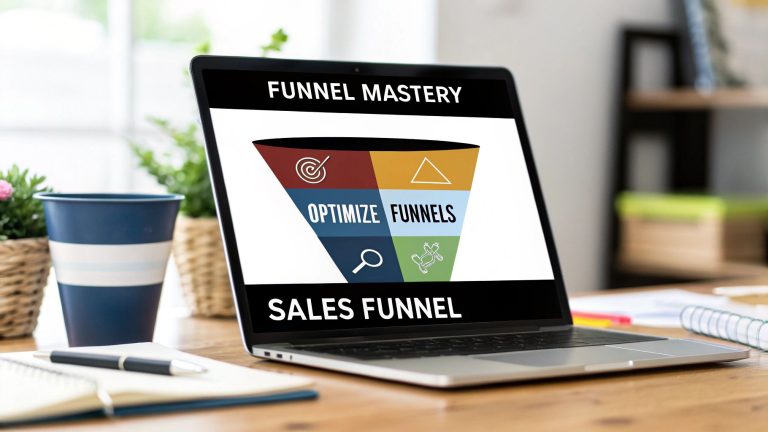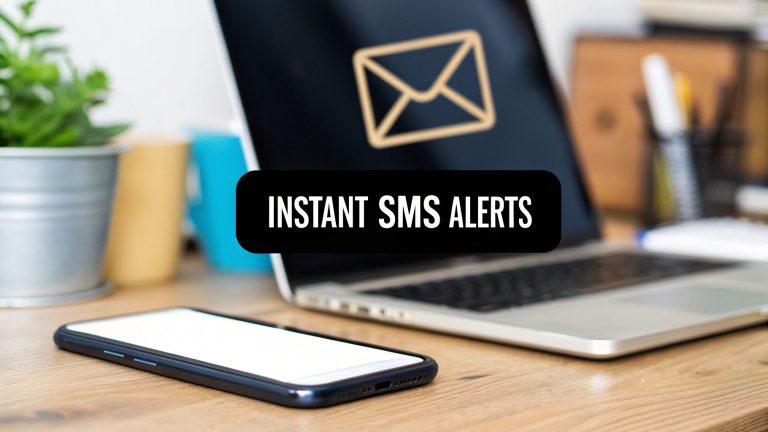6 Powerful Lead Scoring Examples to Use in 2025
In today's competitive market, your sales and marketing teams can't afford to waste time on unqualified leads. The key to unlocking efficiency and driving revenue lies in a robust lead scoring system, a methodical approach to ranking prospects based on their perceived value. But where do you start? A one-size-fits-all model doesn't exist. To truly stop guessing and accurately identify valuable prospects, it's crucial to understand a range of effective lead qualification methods.
The most successful companies tailor their scoring based on their industry, sales cycle, and ideal customer profile. This article moves beyond theory to provide actionable frameworks you can adapt. We will dive deep into six proven lead scoring examples, dissecting the strategic logic behind each model, from classic methodologies like BANT to advanced AI-driven systems. By exploring these diverse approaches, you'll gain the specific, tactical insights needed to build or refine a scoring system that delivers truly sales-ready leads. This ensures your team focuses its efforts where they'll have the greatest impact, separating genuine prospects from the pretenders.
1. HubSpot's Attribution-Based Lead Scoring
HubSpot’s approach to lead scoring has become an industry benchmark, particularly for its powerful blend of explicit, implicit, and negative scoring criteria. The system moves beyond simple point assignments by incorporating attribution models and predictive analytics. This allows marketers to not only track what a lead does but also understand which touchpoints most significantly contribute to their conversion, making it one of the most effective lead scoring examples for B2B and SaaS companies.
At its core, HubSpot's system assigns positive or negative points based on a lead’s attributes (like job title or company size) and their behaviors (like page views, form submissions, or email opens). What sets it apart is its predictive scoring feature, which uses machine learning to analyze the traits and actions of your historical customers and identify the commonalities that signal a high-quality lead.
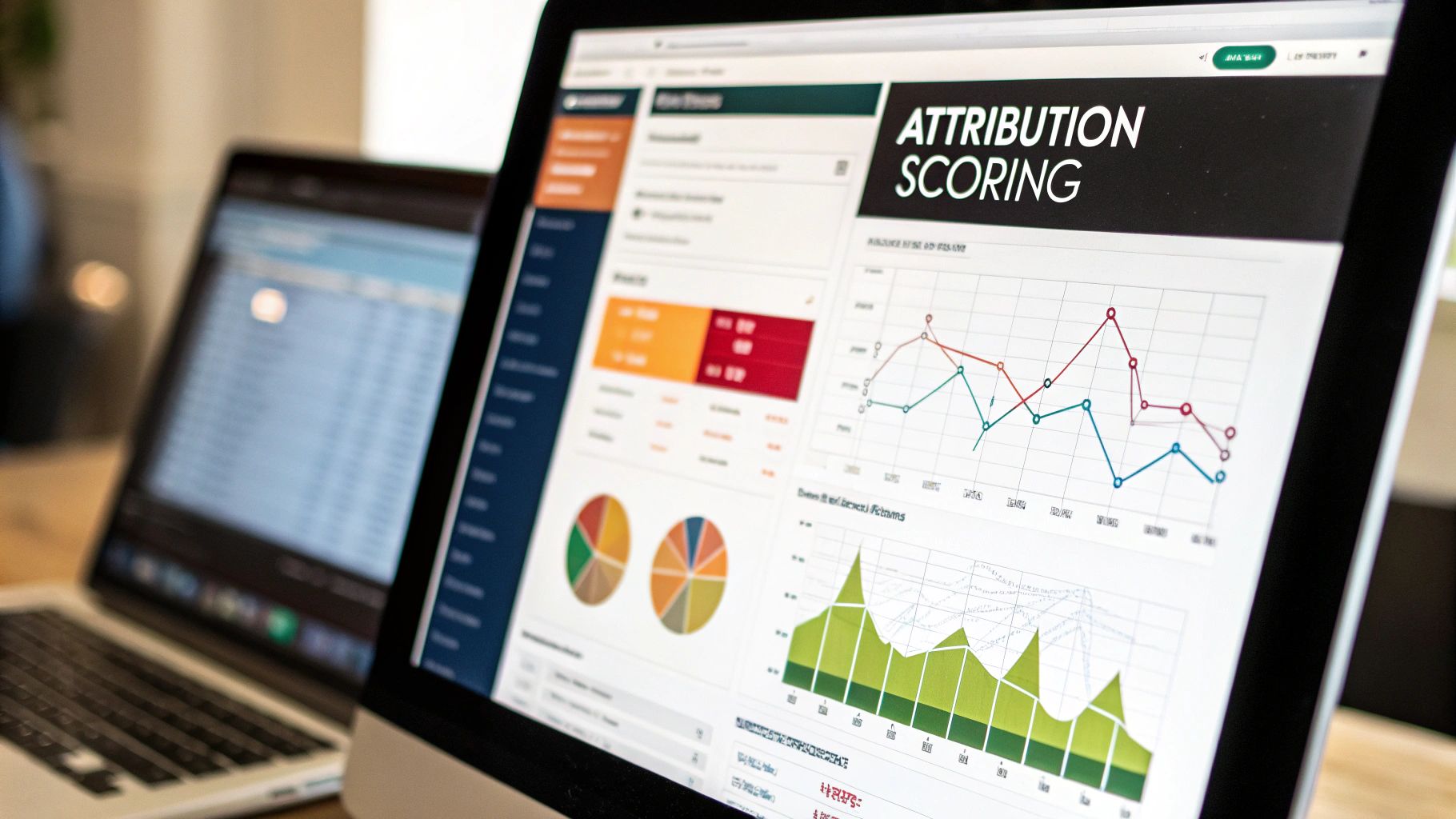
Strategic Analysis & Breakdown
The true power of this model lies in its continuous, automated refinement. Instead of relying on static, manually set rules that can quickly become outdated, HubSpot's predictive scoring adapts as your business evolves and gathers more data.
For instance, a lead who watches 75% of a product demo video is clearly more engaged than someone who just visits the homepage. For those utilizing HubSpot, understanding how interactive video can enhance your activity feed and custom properties is crucial for more accurate lead scoring, as detailed in an article on integrating interactive video actions with HubSpot. This level of granular tracking provides a much richer data set for the scoring algorithm.
Key Strategic Insight: HubSpot’s model bridges the gap between marketing activities and sales outcomes. By scoring leads based on conversion-proven data, it ensures the sales team focuses only on the most promising opportunities, dramatically improving efficiency.
Companies like Vidyard leveraged this to increase their volume of marketing qualified leads (MQLs) by 40%, while InsightSquared saw a 25% boost in sales efficiency by automating lead prioritization.
Actionable Takeaways & Implementation
To replicate this success, start by establishing a clear baseline and then iterate.
- Start with Defaults, Then Customize: Use HubSpot’s default scoring properties as your foundation. Assign high-value points for actions like "Request a Demo" (+50) and lower points for top-of-funnel activities like "Ebook Download" (+10).
- Implement Negative Scoring: Actively use negative scoring to disqualify poor-fit leads. For example, apply -100 points for leads with a freemail address (e.g., gmail.com, yahoo.com) or those from a non-target country.
- Align with Lifecycle Stages: Your lead score should directly influence a contact's lifecycle stage. Set automation rules to change a lead's status to "Marketing Qualified Lead" once they hit a specific score threshold (e.g., 70 points), triggering a handoff to the sales team.
- Create a Feedback Loop: Schedule regular meetings with your sales team to review the quality of leads they are receiving. Are the high-scoring leads actually converting? Use their qualitative feedback to adjust your scoring criteria.
2. Salesforce Pardot's Grading and Scoring System
Salesforce Pardot offers a sophisticated, two-dimensional approach that distinguishes it from many other lead scoring examples. Instead of a single metric, Pardot uses a dual system: numerical scoring for prospect engagement and letter grading for demographic fit. This allows sales and marketing teams to prioritize leads who are not just highly interested (high score) but also a perfect match for their ideal customer profile (high grade).
The system operates on two parallel tracks. Scoring assigns points for implicit behaviors like downloading a whitepaper, visiting the pricing page, or attending a webinar. Grading, on the other hand, assigns a letter grade (from A+ to F) based on explicit data points such as job title, industry, company size, and geographic location. A lead with a high score but a low grade might be an engaged student, while a lead with a high grade but a low score represents a perfect-fit prospect who needs more nurturing.
This summary highlights the core components and proven results of Pardot's dual-methodology approach.
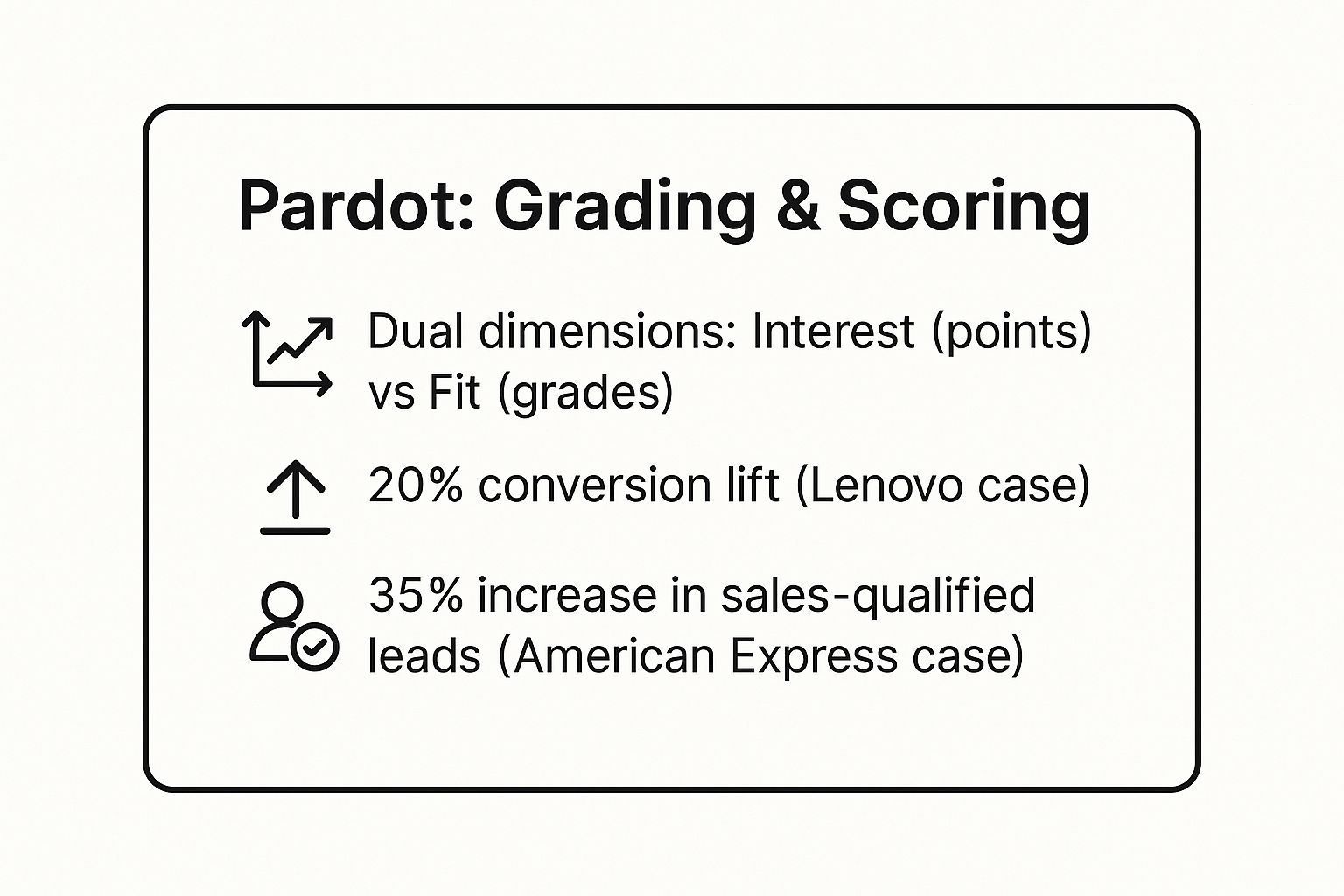
The data clearly demonstrates how separating interest from fit enables companies to achieve significant, measurable gains in both lead conversion and qualification efficiency.
Strategic Analysis & Breakdown
The genius of Pardot's model, originally conceived by co-founder Adam Blitzer, is its ability to answer two critical questions simultaneously: "Is this lead interested in us?" and "Are we interested in this lead?" This prevents sales teams from wasting time on enthusiastic but unqualified prospects, a common pitfall of single-metric scoring systems.
For example, Lenovo successfully used this grading system to refine its lead qualification process, resulting in a 20% increase in lead conversion rates. Similarly, American Express leveraged behavioral scoring to achieve a 35% improvement in their sales-qualified lead rate, ensuring their sales reps connected with prospects who showed genuine buying intent.
Key Strategic Insight: Pardot's dual system creates a priority matrix. The "A-grade" leads with high scores are the immediate, hot opportunities. This segmentation allows for more tailored marketing automation, sending nurturing content to high-grade, low-score leads and different messaging to low-grade, high-score leads.
Actionable Takeaways & Implementation
Implementing Pardot's model requires a clear definition of both dimensions from the outset.
- Define Your Ideal Profile for Grading: Collaborate with sales to build a detailed ideal customer profile (ICP). Assign grade adjustments based on how closely a lead matches this profile. For instance, a "Director" title in a target industry might increase a grade by a full letter, while a "Student" title might decrease it.
- Establish Clear Scoring Thresholds: Map your scoring values to key buying signals. A "Request a Demo" form submission could be worth +50 points, while a simple email open is only +1. Set a score (e.g., 100 points) that automatically qualifies a lead for sales outreach.
- Implement Lead Decay: Use Pardot's automation to decrease a prospect's score if they become inactive for a certain period (e.g., subtract 20 points after 30 days of no engagement). This keeps your pipeline fresh and focused on currently active leads.
- Align Thresholds with Sales Capacity: Set your MQL threshold (the combination of a grade and score) based on what your sales team can realistically handle. If they are overwhelmed, raise the threshold; if they need more leads, lower it. This ensures a balanced and efficient lead flow.
3. Marketo's Behavioral Lead Scoring
Marketo, now part of Adobe Experience Cloud, pioneered a lead scoring model that places a heavy emphasis on behavioral indicators. This approach creates a comprehensive profile of a prospect's engagement by tracking and scoring a wide array of digital interactions. The system meticulously assigns points for actions like email clicks, specific page visits, content downloads, and webinar attendance, providing a nuanced view of a lead's genuine interest level and buying intent.
At its core, Marketo’s model operates on a dual-axis system: demographic/firmographic fit and behavioral engagement. While demographic data confirms if a lead is the right person, behavioral data reveals if it is the right time. This makes it one of the most powerful lead scoring examples for B2B marketers who need to distinguish between passive researchers and active buyers within their target audience.
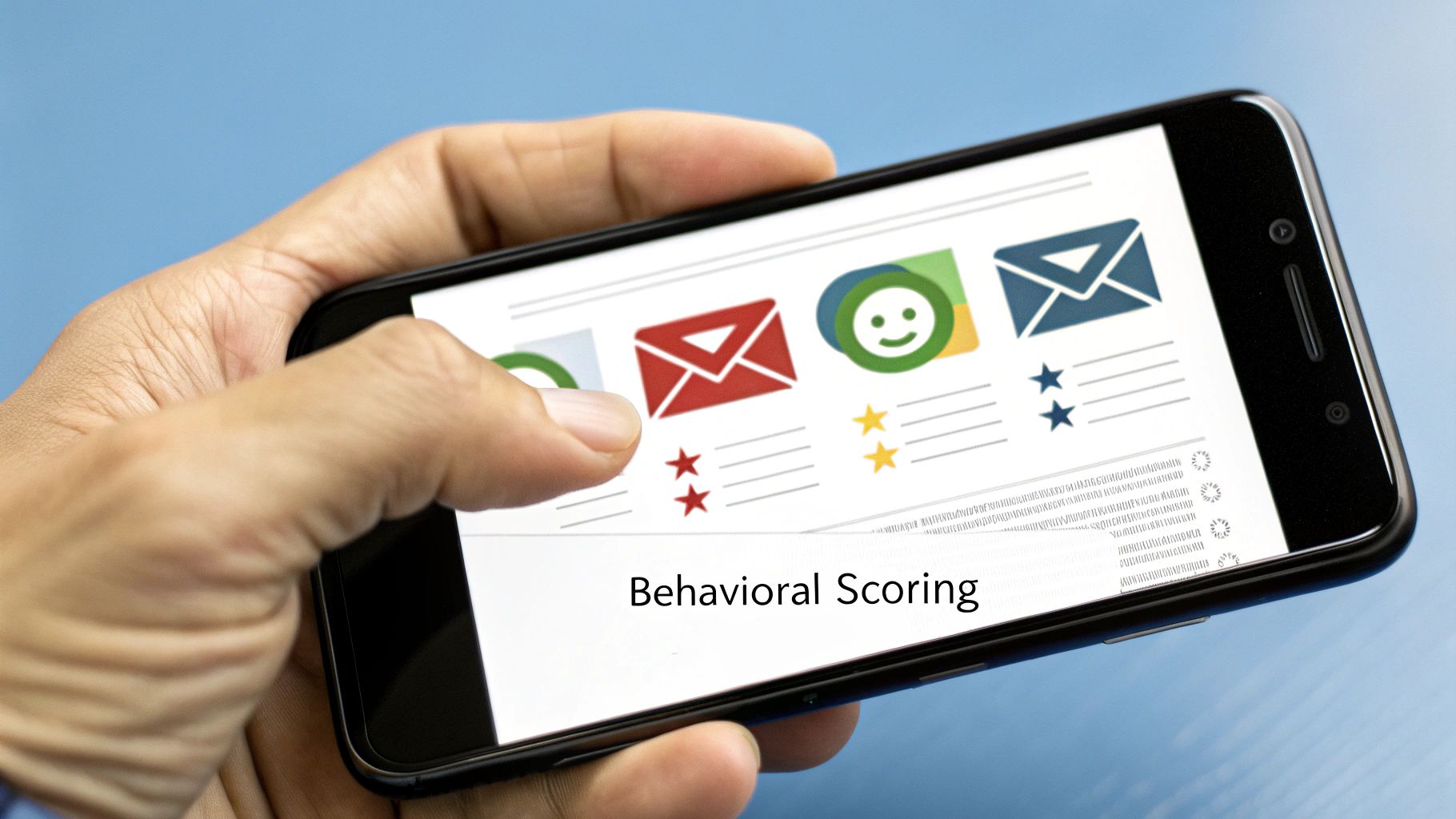
Strategic Analysis & Breakdown
The strength of Marketo's model is its ability to score micro-interactions that, when combined, paint a clear picture of sales-readiness. It acknowledges that not all actions are equal; for instance, a visit to the pricing page is a much stronger buying signal than a visit to the company blog. This granular tracking helps teams prioritize leads with surgical precision.
This detailed behavioral analysis is a cornerstone of modern CRM and lead generation strategies, allowing for more dynamic and responsive marketing campaigns. Integrating such a scoring system effectively means having a robust understanding of how CRM platforms can be leveraged. To dive deeper, you can explore more about CRM's role in lead generation on leadsavvy.pro.
Key Strategic Insight: Marketo’s model excels at identifying momentum. By tracking the frequency and recency of actions, it captures a lead’s escalating interest, allowing sales teams to engage at the peak moment of intent.
This approach has driven significant results for major companies. Panasonic, for example, used Marketo's behavioral scoring to improve its lead quality by an astounding 300%, and Canon increased its volume of marketing qualified leads by 600% after implementing a more refined scoring model.
Actionable Takeaways & Implementation
To implement a Marketo-style behavioral scoring system, focus on defining high-value actions and establishing clear thresholds.
- Prioritize High-Intent Behaviors: Assign the highest point values to actions that signal strong purchase intent. For example: "Pricing Page Visit" (+15), "Demo Request" (+40), or "Free Trial Signup" (+50).
- Implement Score Decay: A lead's actions become less relevant over time. Implement a time-decay rule to reduce a lead's score if they are inactive for a certain period (e.g., subtract 10 points for every 30 days of inactivity). This keeps your pipeline fresh and focused on currently engaged prospects.
- Use Separate Scores: Create distinct scores for demographics (fit) and behavior (interest). A lead must meet a minimum threshold in both categories to become an MQL. This prevents sales from chasing well-engaged but poor-fit leads.
- Test and Refine Thresholds: Continuously work with your sales team to define and adjust the score that triggers a lead's handoff to sales. Start with a baseline (e.g., a total score of 100) and modify it based on the conversion rates and feedback from the sales floor.
4. BANT Framework Lead Scoring
The BANT (Budget, Authority, Need, Timeline) framework is a classic sales qualification methodology, famously popularized by IBM, that has been brilliantly adapted into a powerful lead scoring model. Instead of relying solely on engagement metrics, this approach systematically scores leads based on their direct answers to fundamental qualifying questions. It provides a clear, structured way to evaluate a prospect's sales-readiness, making it one of the most enduring lead scoring examples for high-value B2B and enterprise sales.
In a BANT model, points are explicitly awarded as you gather information about a lead's financial capacity, decision-making power, specific pain points, and purchase timeline. This information is often collected through form fields, discovery calls, or chatbot interactions. A lead who has a dedicated budget and the authority to sign off is inherently more valuable than an intern researching solutions for a future project.
Strategic Analysis & Breakdown
The primary strength of the BANT model is its directness. It cuts through the ambiguity of behavioral scoring by focusing on the core attributes that define a viable sales opportunity. While a lead might download ten ebooks, if they have no budget or authority, they are not a qualified lead for the sales team. This framework forces a clear alignment between marketing data collection and core sales requirements.
Many consulting firms and enterprise software companies use BANT to qualify prospects for complex, project-based sales processes. For example, a lead indicating a project timeline of "within 3 months" would receive significantly more points than one with a "12+ month" timeline. Mastering this kind of qualification is a cornerstone of an effective sales process, as explained in this guide on the sales lead qualification process. This ensures that sales resources are dedicated only to opportunities with a real chance of closing.
Key Strategic Insight: BANT scoring prioritizes sales-readiness over simple marketing engagement. It creates a powerful filter that prevents the sales pipeline from being clogged with well-researched but ultimately unqualified leads, improving conversion rates and shortening the sales cycle.
Historically, IBM used this method to ensure its large sales teams were focusing on enterprise deals that had the necessary internal backing and financial resources to move forward, drastically improving their forecasting accuracy.
Actionable Takeaways & Implementation
To implement a BANT-based model, you must strategically gather qualification data over time.
- Use Progressive Profiling: Don't ask all BANT questions on the first form. Start by asking about "Need" on an initial content download. Later, ask about "Authority" (Job Title) and "Timeline" on a webinar registration form. This gradual approach increases conversion rates.
- Weight Criteria Strategically: Assign point values based on your ideal customer. For a high-ticket item, you might assign points like this: Budget Confirmed (+30), C-Suite/VP Authority (+25), Urgent Need (+20), and Timeline < 3 months (+15).
- Combine with Behavioral Data: A pure BANT model can be rigid. Enhance it by adding behavioral scores. A C-level executive (Authority: +25) who also visits your pricing page (Behavior: +10) is an extremely hot lead.
- Train Your Team: Ensure both marketing and sales understand the criteria. Sales development representatives (SDRs) should be trained to ask BANT-related questions on discovery calls to fill in any data gaps and validate the lead's score.
5. Predictive Lead Scoring with Machine Learning
Predictive lead scoring represents a significant evolution from traditional, rules-based systems. This advanced approach uses artificial intelligence (AI) and machine learning algorithms to analyze vast amounts of historical customer data, automatically identifying the complex patterns and attributes that signal a high likelihood to convert. Instead of marketers manually setting point values, the system learns from past successes and failures, continuously refining its scoring model for superior accuracy.
This method is particularly powerful for businesses with large data sets, as the model becomes more intelligent over time. Companies like Salesforce (with its Einstein AI) and Microsoft have championed this approach, leveraging it to move beyond simple behavioral tracking. The system analyzes thousands of data points, both explicit and implicit, to build a profile of an ideal customer and then scores incoming leads based on their resemblance to that profile. This makes it one of the most dynamic and effective lead scoring examples available today.
Strategic Analysis & Breakdown
The core strength of a predictive model is its ability to uncover non-obvious conversion signals that human analysis might miss. It can identify subtle correlations, such as the specific combination of a lead's industry, their sequence of content downloads, and the time of day they are most active. This moves scoring from a "best guess" to a data-driven probability.
For instance, Zillow uses machine learning not just to value homes but to score potential seller leads. The algorithm analyzes property data, market trends, and a homeowner's on-site behavior (like using a mortgage calculator or saving certain searches) to predict their intent to sell. This allows Zillow's agent network to engage leads with unprecedented timing and relevance. Improving the accuracy of these signals is a key component in any strategy aimed at enhancing lead quality; you can explore more techniques for this by learning how to improve lead quality with advanced methods.
Key Strategic Insight: Predictive scoring automates the optimization process. It eliminates the need for constant manual adjustments and internal debates over point values, allowing the model to adapt in real-time to shifting market dynamics and customer behaviors.
Microsoft demonstrated the power of this by using its own predictive analytics tools to overhaul its lead management process. The result was a remarkable 30% increase in lead conversion rates by ensuring sales reps focused only on leads statistically proven to be purchase-ready.
Actionable Takeaways & Implementation
Adopting a predictive model requires a solid data foundation and a methodical approach.
- Ensure Data Sufficiency: You need a significant volume of historical data, including both converted and lost leads. A common benchmark is at least 1,000 conversions to provide the algorithm with enough examples to learn from.
- Start with Key Firmographics: Begin by feeding the model critical firmographic and demographic data like company size, industry, job title, and geographic location. These explicit data points provide a strong baseline.
- Integrate Behavioral Data: Layer in behavioral data, including website page views, email engagement, content downloads, and social media interactions. The model will determine the relative importance of each action.
- Validate and Iterate: Don't treat the model as a "black box." Regularly validate its predictions against actual sales outcomes. If high-scoring leads aren't converting, use that feedback to retrain the model with updated data, ensuring its long-term accuracy and alignment with business goals.
6. Account-Based Lead Scoring
For businesses targeting large, complex organizations, scoring individual leads in isolation is inefficient. Account-Based Lead Scoring shifts the focus from the person to the organization, evaluating leads based on the strategic value of their parent company. This model combines individual lead scores with an overarching account score, ensuring that sales efforts are directed at high-value companies showing collective buying intent.
This approach, championed by platforms like Demandbase and 6sense, is essential for enterprise sales. It recognizes that multiple decision-makers are involved in a B2B purchase. An engaged manager at a target company is far more valuable than a highly engaged intern at a small, non-target firm. The model assesses the entire account's fit and engagement level, providing a holistic view of the opportunity.

Strategic Analysis & Breakdown
The core strength of account-based scoring is its alignment with modern B2B sales cycles. Instead of waiting for a single lead to become an MQL, this system aggregates engagement signals from multiple contacts within the same account. When the combined activity from several individuals at a target company (e.g., a VP downloads a whitepaper, a manager attends a webinar, and a director visits the pricing page) crosses a threshold, the entire account is flagged as "sales-ready."
For instance, Adobe uses this method to prioritize its enterprise opportunities. It identifies target accounts based on firmographics like industry and revenue, then tracks engagement across all known contacts. This ensures their top sales talent focuses only on accounts demonstrating genuine, widespread interest, preventing wasted cycles on individual leads who lack buying authority or internal support.
Key Strategic Insight: Account-based scoring aligns marketing and sales resources directly with revenue potential. It moves the conversation from "who is this lead?" to "is this account a good fit and are they ready to buy?" This is one of the most powerful lead scoring examples for companies with a defined Ideal Customer Profile (ICP).
Actionable Takeaways & Implementation
Implementing an account-based model requires a shift in mindset and tooling.
- Define Your Account-Level ICP: Before scoring anything, clearly define your ideal customer profile at the company level. Key firmographics might include industry, annual revenue, employee count, and technology stack. Assign points based on how closely an account matches this profile.
- Track Multi-Contact Engagement: Use a platform that can map leads to their respective accounts and aggregate their activities. A single visit to your pricing page might be worth +10 points, but three visits from different people at the same account could trigger a +50 point account-level score boost.
- Weight Account Fit Heavily: An individual's score should be significantly influenced by their company's score. For example, a lead from a Tier 1 target account might get an automatic +40 points, while a lead from a non-target industry might get -50 points, regardless of their personal engagement.
- Align Sales Territories: Structure sales territories around account tiers. Your top-tier accounts, identified through scoring, should be assigned to your most experienced sales reps to maximize the chances of closing high-value deals.
Lead Scoring Methods Comparison
| Lead Scoring Method | Implementation Complexity (🔄) | Resource Requirements (⚡) | Expected Outcomes (📊⭐) | Ideal Use Cases (💡) | Key Advantages (⭐💡) |
|---|---|---|---|---|---|
| HubSpot's Attribution-Based Lead Scoring | Moderate – easy setup, ongoing tuning | Medium – data volume needed for ML | Improved lead qualification, 25-40% increase in conversions | SMBs needing all-in-one, low-complexity automated scoring | Automated ML refinement, seamless HubSpot integration |
| Salesforce Pardot's Grading and Scoring System | High – technical setup, learning curve | High – licensing and skilled staff | 20-35% lift in qualified leads, improved prioritization | Enterprise B2B with complex sales and dedicated marketing teams | Dual dimension scoring, strong B2B focus, highly customizable |
| Marketo's Behavioral Lead Scoring | High – complex setup and maintenance | High – requires extensive data and staff | Significant lead quality improvements (300-600%) | Marketing-focused orgs with multi-channel long sales cycles | Advanced behavior tracking, flexible customization |
| BANT Framework Lead Scoring | Low – simple, straightforward | Low – minimal technical resources | Reliable basic qualification, used in traditional B2B sales | Traditional sales with clear buyer hierarchies | Simple criteria, easy to understand and train |
| Predictive Lead Scoring with ML | Very High – requires data science expertise | Very High – large datasets and analytics | 30%+ conversion uplift, highly accurate predictions | Large data-rich orgs with advanced analytics teams | AI-powered accuracy, automatic adaptation to new data |
| Account-Based Lead Scoring | High – complex data and process management | High – needs account intelligence | Better targeting of high-value accounts, improved alignment | Enterprise B2B with ABM strategies and buying committees | Aligns scoring with account strategy, multi-contact nurturing |
From Examples to Execution: Building Your Winning Lead Scoring Strategy
Throughout this guide, we've journeyed through a diverse landscape of powerful lead scoring examples. From the attribute-focused model of HubSpot to Salesforce Pardot's dual-axis grading system, and from Marketo's nuanced behavioral tracking to the strategic precision of Account-Based and Predictive models, a clear theme has emerged. The most effective lead scoring system is never a one-size-fits-all template; it's a bespoke engine built specifically for your unique sales cycle, customer profile, and business objectives.
The power of these models lies not in their complexity, but in their alignment with your reality. The BANT framework, for example, provides a beautifully simple yet effective filter for B2B sales, while a machine-learning model can uncover hidden correlations in a high-volume B2C environment. The key is to see these examples not as rigid blueprints, but as a rich palette of ideas from which to draw inspiration.
Synthesizing the Strategies: Your Action Plan
Translating these examples into a functional system requires a strategic, step-by-step approach. Your journey from insight to implementation starts now. The critical takeaway is that successful lead scoring is a collaborative and iterative process.
Your immediate next steps should be to:
- Conduct a Historical Data Audit: Dive into your CRM and sales data. Identify the common threads among your best customers. What firmographics (company size, industry), demographics (job title, seniority), and behaviors (webinar attendance, pricing page visits) did they share before converting? This analysis forms the bedrock of your scoring criteria.
- Bridge the Sales and Marketing Divide: Schedule a workshop with your sales team. Their frontline experience is invaluable. Together, you must define, in concrete terms, what constitutes a "Sales Qualified Lead" (SQL). This collaboration ensures that marketing is delivering leads that sales actually wants, preventing friction and improving morale.
- Choose Your Starting Point: You don't need to implement a predictive AI model overnight. Begin with a simple, manual point system based on your initial data audit and sales feedback. This foundational model can be managed in a spreadsheet and will provide immediate value while you evaluate more sophisticated platforms.
The Real Value: Speed, Alignment, and Growth
Mastering lead scoring transcends simply organizing contacts; it fundamentally transforms your go-to-market motion. It instills a data-driven culture, forcing alignment between marketing and sales and focusing everyone’s energy on the opportunities with the highest probability of closing. This focus is the engine of efficient, sustainable growth.
Remember, a lead's value decays rapidly. This is especially true for leads generated from fast-paced platforms like Facebook Ads. A perfectly scored lead is useless if your sales team doesn't receive it until hours or days later. The operational link between lead capture and sales action is just as critical as the scoring logic itself. Lead scoring is not a static project but a dynamic discipline. You must commit to a cycle of regular review, testing, and refinement to adapt to evolving customer behaviors and market conditions. By embracing this iterative philosophy, you will transform your lead management from a reactive chore into a proactive, revenue-generating machine.
Ready to ensure your perfectly scored leads get the immediate attention they deserve? LeadSavvy Pro instantly syncs your Facebook Lead Ads to Google Sheets, your CRM, and your email, eliminating dangerous delays. Start turning hot leads into closed deals faster by visiting LeadSavvy Pro and automating your lead delivery today.


